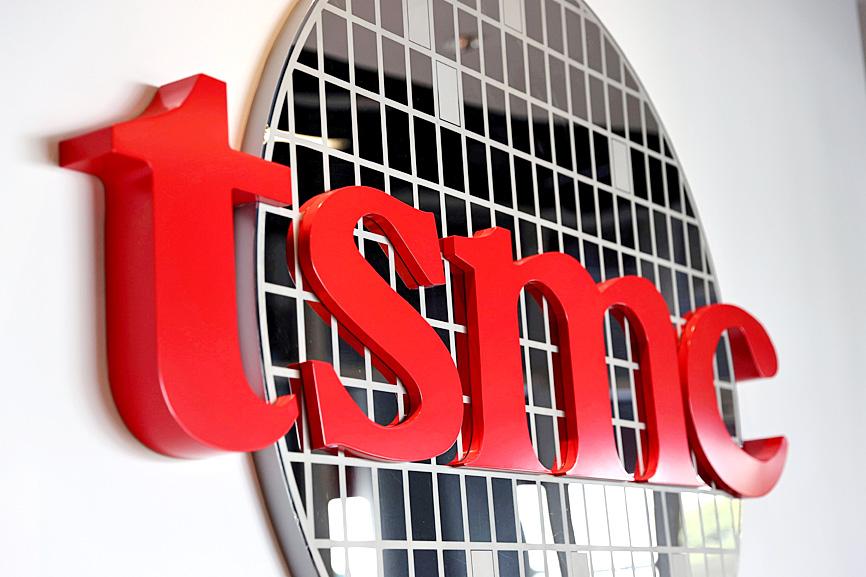Taiwan Semiconductor Manufacturing Co (TSMC, 台積電) is in early talks with the German government about potentially establishing a plant in the country, a senior executive said on Saturday.
Various factors, including government subsidies, customer demand and the talent pool, would influence its final decision, TSMC senior vice president of Europe and Asia sales Lora Ho (何麗梅) told reporters on the sidelines of a technology forum in Taipei.
The discussions come as the EU and others seek to increase domestic chip production to mitigate the risk of supply chain disruptions.

Photo: Ann Wang, Reuters
The chipmaker has not discussed incentives with Berlin or decided on a location, Ho said.
TSMC chairman Mark Liu (劉德音) in June told shareholders that the Hsinchu-based company had begun assessments on setting up manufacturing operations in the European country.
The world’s largest contract chipmaker, which mostly produces domestically, has started to diversify over the past year to help meet demand in various major countries seeking to bolster domestic semiconductor production out of national security and self-sufficiency concerns.
It is building a US$12 billion facility in Arizona, and is set to soon start construction of a US$7 billion plant in Japan.
Meanwhile, the EU said it would unveil the “European Chips Act” in the first half of next year as part of its strategy to boost semiconductor production.
One of the goals would be to account for 20 percent of global production by 2030, the bloc said.
Separately, research teams at Intel Corp on Saturday unveiled work that the US company believes would help it keep speeding up and shrinking computing chips over the next 10 years, with several technologies aimed at stacking parts of chips on top of each other.
Intel’s Research Components Group introduced the work in papers at an international conference held in San Francisco.
The company is working to regain a lead in making the smallest, fastest chips that it has lost in the past few years to rivals like TSMC and Samsung Electronics Co.
The newly unveiled research gives a look into how Intel plans to compete beyond 2025.
One of the ways Intel is packing more computing power into chips by stacking up “tiles” or “chiplets” in three dimensions rather than making horizontally designed chips, it said.
Intel showed work that could allow for 10 times as many connections between stacked tiles, meaning that more complex tiles can be stacked on top of one another.
However, perhaps the biggest advance showed at the event was a research paper demonstrating a way to stack transistors — tiny switches that form the most basic building blocks of chips by representing the ones and zeros of digital logic — on top of one another.
Intel believes the technology would yield a 30 to 50 percent increase in the number of transistors it can pack into a given area on a chip.
Raising the number of transistors is the main reason chips have consistently gotten faster over the past 50 years.
“By stacking the devices directly on top of each other, we’re clearly saving area,” Intel Components Research Group director Paul Fischer said. “We’re reducing interconnect lengths and really saving energy, making this not only more cost efficient, but also better performing.”

JITTERS: Nexperia has a 20 percent market share for chips powering simpler features such as window controls, and changing supply chains could take years European carmakers are looking into ways to scratch components made with parts from China, spooked by deepening geopolitical spats playing out through chipmaker Nexperia BV and Beijing’s export controls on rare earths. To protect operations from trade ructions, several automakers are pushing major suppliers to find permanent alternatives to Chinese semiconductors, people familiar with the matter said. The industry is considering broader changes to its supply chain to adapt to shifting geopolitics, Europe’s main suppliers lobby CLEPA head Matthias Zink said. “We had some indications already — questions like: ‘How can you supply me without this dependency on China?’” Zink, who also

Taiwan Semiconductor Manufacturing Co (TSMC, 台積電) received about NT$147 billion (US$4.71 billion) in subsidies from the US, Japanese, German and Chinese governments over the past two years for its global expansion. Financial data compiled by the world’s largest contract chipmaker showed the company secured NT$4.77 billion in subsidies from the governments in the third quarter, bringing the total for the first three quarters of the year to about NT$71.9 billion. Along with the NT$75.16 billion in financial aid TSMC received last year, the chipmaker obtained NT$147 billion in subsidies in almost two years, the data showed. The subsidies received by its subsidiaries —

The number of Taiwanese working in the US rose to a record high of 137,000 last year, driven largely by Taiwan Semiconductor Manufacturing Co’s (TSMC, 台積電) rapid overseas expansion, according to government data released yesterday. A total of 666,000 Taiwanese nationals were employed abroad last year, an increase of 45,000 from 2023 and the highest level since the COVID-19 pandemic, data from the Directorate-General of Budget, Accounting and Statistics (DGBAS) showed. Overseas employment had steadily increased between 2009 and 2019, peaking at 739,000, before plunging to 319,000 in 2021 amid US-China trade tensions, global supply chain shifts, reshoring by Taiwanese companies and

At least US$50 million for the freedom of an Emirati sheikh: That is the king’s ransom paid two weeks ago to militants linked to al-Qaeda who are pushing to topple the Malian government and impose Islamic law. Alongside a crippling fuel blockade, the Group for the Support of Islam and Muslims (JNIM) has made kidnapping wealthy foreigners for a ransom a pillar of its strategy of “economic jihad.” Its goal: Oust the junta, which has struggled to contain Mali’s decade-long insurgency since taking power following back-to-back coups in 2020 and 2021, by scaring away investors and paralyzing the west African country’s economy.